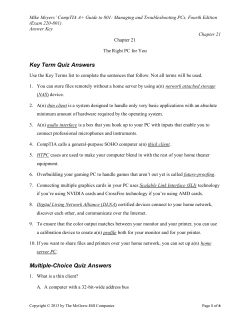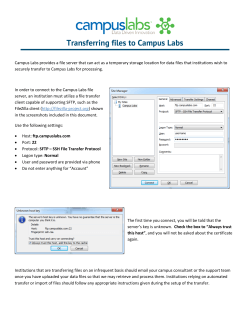
Courseware Outline
Course overview CompTIA Network+ N10-006 Official Study Guide (G524eng ver035) Overview ___________________________________________________________________________________________ This 5-day course is intended for those wishing to qualify with CompTIA Network+ Certification. Network+ is foundation-level certification designed for IT professionals with 1 year's experience whose job role is focused on network administration. The CompTIA Network+ certification will certify that the successful candidate has the knowledge and skills required to troubleshoot, configure, and manage common network wireless and wired devices, establish basic network design and connectivity, understand and maintain network documentation, identify network limitations and weaknesses, and implement network security, standards, and protocols. The candidate will have a basic understanding of emerging technologies including unified communications, mobile, cloud, and virtualization technologies. CompTIA Network+ Syllabus Courseware with Integrated Learning from Professor Messer Professor Messer has long been a web hero for CompTIA certification students. For many years, Professor Messer has provided video-based training courses for CompTIA certifications. With professionally-produced lessons covering the full exam objectives and online forums, Professor Messer is a trusted online source for exam information. Now, gtslearning has partnered with Professor Messer to take this learning to a new level. You will be able to study from the gtslearning courseware and link to the appropriate training video (by QR code, hyperlink or typing short URL) for further explanation. Equally, a student studying from the Professor Messer video course will be able to easily follow his video presentations using the same CompTIA CAQC Official courseware. Certification track This courseware bears the seal of CompTIA Approved Quality Content. This seal signifies this content covers 100% of the exam objectives and implements important instructional design principles. CompTIA recommends multiple learning tools to help increase coverage of the learning objectives. The contents of this training material were created for the CompTIA Network+ Certification N10-006 exam covering the 2015 Edition Network+ certification exam objectives. gtslearning 1998-2015. All rights reserved. All trademarks are the property of their respective owners. 1 Target audience and course prerequisites _______________________________________________________ CompTIA Network+ is aimed at IT professionals with job roles such as network administrator, network technician, network installer, help desk technician and IT cable installer. Ideally, you should have successfully completed the "CompTIA A+ Support Skills" course, achieved CompTIA A+ certification, and have around 9-12 months' experience of networking support or IT administration. It is not necessary that you pass the A+ exams before completing Network+ certification, but it is recommended. Regardless of whether you have passed A+, it is recommended that you have the following skills and knowledge before starting this course: Configure and support PC, laptop, mobile (smartphone/tablet), and print devices. Know basic network terminology and functions (such as Ethernet, TCP/IP, switches, routers). Configure and manage users, groups, and shared resources in a simple SOHO network. Understand the use of basic access control measures, such as authentication, security policy, encryption, and firewalls. Course outcomes ___________________________________________________________________________________ This course will teach you the fundamental principles of installing, configuring, and troubleshooting network technologies and help you to progress a career in network administration. It will prepare you to take the CompTIA Network+ exam by providing 100% coverage of the objectives and content examples listed on the syllabus. Study of the course can act as groundwork for more advanced training. The CompTIA Network+ credential proves knowledge of networking features and functions and is the leading vendorneutral certification for networking professionals. Worldwide nearly 500,000 individuals are CompTIA Network+ certified and 91% of hiring managers indicate CompTIA certifications are valuable in validating IT employee skills and expertise. Dell, HP, Sharp, Xerox and Ricoh are among the companies that employ Network+ certified staff and it is supported by top organizations, such as Apple, Best Buy, Canon, Cisco, Intel and U.S. Navy. On course completion, you will be able to: Describe the features of different network protocols and products for LANs, WANs, and wireless networks. Understand the functions and features of TCP/IP addressing and protocols. Identify threats to network resources and appropriate security countermeasures. Install and configure network cabling and appliances. Manage, monitor, and troubleshoot networks. gtslearning 1998-2015. All rights reserved. All trademarks are the property of their respective owners. 2 Course contents ____________________________________________________________________________________ The course consists of a study volume, containing indexed notes and review questions, plus exam objectives mapping, exam information, and a comprehensive glossary. The course also comes with an online practice exam, pre-requisites test, pre-/post-unit assessment tests plus written scenarios to test your ability to select appropriate technologies and configuration options for given tasks. An instructor edition of the course is available with margin notes and tips for the trainer. Access to course resources (setup guides and data, PowerPoint slides, timetables, and extra exam information) is also available, subject to meeting minimum order requirements. A full set of classroom labs is provided to training companies and there are also options for hosted labs and self-paced labs to accompany the course. Module 1 / Topologies and Infrastructure Topologies and the OSI Model • Key Features of Networks • Clients and Servers • Network Topologies • The OSI Model • Physical Layer • Data Link Layer • Network Layer • Upper Layers • OSI Model Summary Ethernet • Media Types and Modulation • Signaling • Media Access Control • Ethernet Frames • Legacy Ethernet Standards • Modern Ethernet Standards • MAC Addressing • Address Resolution Protocol (ARP) • Protocol Analyzers • Labs • Configuring a Network Adapter • Using Hyper-V • ARP and Packet Analysis Hubs, Bridges, and Switches • Hubs and Bridges • Switches • Managing a Switch • Switch Interface Configuration • Virtual LANs (VLAN) • Spanning Tree Protocol (STP) • Power over Ethernet (PoE) Infrastructure and Design • Network Infrastructure Implementations • Planning an Enterprise Campus Network • Planning a SOHO Network Installation • Planning an Industrial Control System • TCP/IP Protocol Suite Module 2 / Addressing and Routing Internet Protocol • Internet Protocol Basics • Subnet Masks • ipconfig / ifconfig • IP Routing Basics • ICMP and ping • Labs • IP Address Configuration IPv4 Addressing • IP Addressing Schemes • Subnetting and Classless Addressing • Planning an IP Addressing Scheme • Public Internet Addressing • Multicast and IGMP • Labs • IP Addressing Schemes DHCP and APIPA • Static versus Dynamic IP Addressing • Configuring DHCP • Labs • Configuring DHCP Clients and Servers • Labs • Configuring DHCP in Windows • Configuring DHCP in Linux IPv6 Addressing • IPv6 Address Format • IPv6 Addressing Schemes • Configuring IPv6 Addresses • Migrating to IPv6 • Labs • IPv6 Addressing Routing • Routing Basics • Routing Algorithms and Metrics • Routing Protocols • Administrative Distance and Route Redistribution • IPv4 and IPv6 Internet Routing • High Availability Routing • Installing and Configuring Routers • Routing Troubleshooting Tools • Labs • Configuring Routing Module 3 / Troubleshooting and Management Transport Protocols • Transmission Control Protocol (TCP) • User Datagram Protocol (UDP) • TCP/IP Ports • netstat • Labs • TCP and Port Scanning Name Resolution • Host Names and FQDNs • Domain Name System (DNS) • Configuring DNS Servers • nslookup and nbtstat • Labs • Name Resolution • Configuring DNS Troubleshooting • Troubleshooting Procedures • Identifying the Problem • Establishing a Probable Cause • Establishing a Plan of Action • Troubleshooting Connectivity Issues • Troubleshooting Configuration Issues • Troubleshooting Internetworking • Troubleshooting Services Applications and Services • TCP/IP Services • HTTP and HTTPS • FTP, TFTP, and SMB • Email (SMTP / POP / IMAP) • VoIP and VTC • Real-time Services Protocols • Quality of Service • Packet Shapers • Load Balancers • Multilayer Switches• Labs • Configuring Email Services Management and Monitoring • Performance Monitoring • Network Monitoring Utilities • Logs • Analyzing Performance Metrics • Simple Network Management Protocol • Remote Administration Tools • Labs • Performance Testing and Monitoring • Monitoring and Management Tools Cloud and Virtualization • Virtualization Technologies • Storage Area Networks • Cloud Computing gtslearning 1998-2015. All rights reserved. All trademarks are the property of their respective owners. 3 Module 4 / Installation Network Sites • Wiring Distribution • Rack Systems • Safety and ESD • Power Management • HVAC (Heating, Ventilation, Air Conditioning) • Physical Security Controls • Fire Prevention and Suppression Installing Cable • Twisted Pair Cable (UTP / STP / ScTP) • Twisted Pair Connectors • Wiring Tools and Techniques • Cable Testing and Troubleshooting • Other Copper Cable Types • Fiber Optic Cable and Connectors • Media Converters • Troubleshooting Fiber Cable Issues Installing Wireless Networks • Wireless Standards (IEEE 802.11) • Wireless Network Topologies • Wireless Site Design • Site Surveys and Antenna Placement • Troubleshooting Wireless Links WAN Technologies • WAN Basics • Telecommunications Networks • Modern Telecommunications Networks • Packet-switched WAN Services • Local Loop Services • Wireless WANs Remote Access • Remote Access Services (RAS) • Virtual Private Networks (VPN) • PPTP and SSL VPNs • IP Security (IPsec) • Remote Access Servers • Installing Remote Access Links • Troubleshooting WAN Issues Module 5 / Security Vulnerabilities and Threats • Security Basics • Social Engineering • Network Reconnaissance • Wireless Security • Network Attack Strategies • Denial of Service Security Appliances • Network Segmentation • Demilitarized Zones (DMZ) • Network Address Translation • Firewalls • Configuring a Firewall • Proxies and Gateways • Anti-malware Software • Intrusion Detection Systems (IDS) • Labs • Configuring Certificate Services, HTTPS, and FTPS • Configuring a NAT Firewall Authentication • Authentication Technologies • Cryptographic Hash Functions • NTLM and Kerberos • RADIUS and TACACS+ • PAP, CHAP, and EAP • Wi-Fi Authentication • Endpoint Security • Network Access Control • Mobile Device Management • Troubleshooting Authentication and ACLs • Labs • Authentication Methods and VPNs Incident Response • Business Continuity Concepts • Disaster Recovery Planning • IT Contingency Planning • Training • Incident Response Procedures • Forensic Procedures • Collection of Evidence Change and Configuration Management • Change and Configuration Management • Documentation • Procedures and Standards • Employee Policies • Patch Management • Backup Plans and Policies Index, Exam Tips, Glossary gtslearning 1998-2015. All rights reserved. All trademarks are the property of their respective owners. 4
© Copyright 2025











